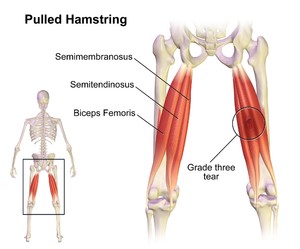Hamstring Injury Symptoms, Causes, and Treatments
Hamstring Injury Symptoms, Causes, and Treatments
A brief summary of hamstring injuries
Hello again! Welcome to the 3rd part of our running injuries series. Today our attention will be directed towards hamstring strains.
I’m sure many of you have either experienced or heard of someone that has suffered from a hamstring injury (muscle strain); so, to paint a nice picture of what the hamstrings are, check this image out:

Here we see the hamstrings consist of three different muscles:
- Semimembranosus
- Semitendinosus
- Biceps femoris
This is helpful for understanding and determining which part of the hamstrings might be injured, which we will go over next. Although, there is much more detail about specific structures that may be affected, and which can affect the healing time, including myofascial, musculotendinous, intratendinous, I will break down grading of hamstring injuries, and the average healing times.
- Grade 1: Mild injuries with minimal pain or no loss of strength and function, minor inflammation.
- Grade 2: Partial or incomplete tears which present with moderate pain, loss of strength/function swelling and bruising might be present.
- Grade 3: Complete tear, severe loss of strength and function, swelling and bruising
Here are the rough estimates of healing times from various sources - keep in mind these are just guidelines and individuals may recover at different rates according to the location of injury, their sporting demands, and multiple other factors (Askling et al, 2013; Hickey et al, 2016; Macdonald et al, 2017).
- *Grade 1: 7 - 27 days
- *Grade 2: 27 - 40 days
- *Grade 3: 40 - 120 days
What Can Cause Hamstring Injuries?
There are several risk factors that are backed by research that can cause hamstring injuries:
- Sudden Increase in activity and training regime (overload)
- Intense sprinting without a warm-up
- Past history of hamstring injury (most likely cause)
- Excessively high quadriceps peak torque (very high force when contracting the quads) forcing the hamstring into over-stretch, if the hamstrings are not strong themselves
- Fatigue
- Weak hamstrings
- Older age
Some of these factors are within our control such as training the hamstrings and monitoring sprinting load; whereas others like previous history of injury and age are out of our control.
How to Know If You Have Injured Your Hamstring
Identifying how the injury happened is actually very important. It will guide the treatment and recovery process and provide a picture of what recovery may look like for your physiotherapist. Did you know that 70% of hamstring injuries are caused by high-speed running? This affects the hamstring muscle on the most outer part of the leg. These type of hamstring injuries tend to heal faster than if you were to injure the most inner hamstring.
Another important factor is that the closer the injury is to the sitting bone, the longer the return to sport will be. Essentially the farther away the site of the injury is from the glutes, the faster the hamstring should heal due to non-tendinous areas being affected. More tendon involvement typically takes longer to heal because of decreased blood flow compared to muscles.
How Do Physiotherapists Treat Hamstring Strains and Reduce Your Chances of Injury?
Appropriate rehabilitation professionals such as Physiotherapists and Chiropractors can provide education, soft tissue treatment, taping, or appropriate exercise prescription to assist with your recovery and prevention of injury.
The current evidence suggests a combination of rest, gradual exercises progression, and loading to the hamstrings as soon as tolerated, in a safe-controlled manner.
Hamstring muscles have been shown to benefit from what is called an “eccentric” movement. This is placing load onto the muscle while it is being stretched. An example of this can be seen in this video here:
Not everyone will be able to tolerate these exercises right away and the intensity of the exercise must be adapted to each individual. This all depends on the severity of the injury and how much the patient can tolerate. If a patient can introduce these movements at an earlier stage, most tend to get better faster!
Keep in mind that each scenario will be different, and I certainly do not recommend rushing into these types of exercises without a proper assessment and discussion with a physiotherapist or chiropractor.
Mild discomfort is okay when performing hamstring rehabilitation. Only go up to a max of two to three out of 10 on a pain scale. Do not force the hamstring to go past any signs of discomfort.
Example Exercises for Hamstring Rehab
Weeks 1-2
Isometric Hamstring heel digs
Aim for 2 sets and 6 reps with this exercise.
Kickstand RDL
Aim for 2 sets and 6 reps for this exercise.
Divers
Aim for 2 sets and 8 reps with this exercise.
90/90
Aim for 2 sets and 8 reps for this exercise.
If you are curious and want to clarify anything else about hamstrings diagnosis, cause, or treatment feel free to contact us or you can book an appointment with one of our physiotherapists here.
About the Author
Jason Chung, MSc PT, BKin, NSCA-CSCS

Jason Chung is an Interim Physiotherapist and NSCA certified strength and conditioning coach at Strive Health and Performance. Jason is currently pursuing advanced training in musculoskeletal assessment and rehabilitation to better assist his patients with their recovery. He is also undergoing training through the Sport Physiotherapy Canada credentialing program to improve his knowledge in sport specific injuries. In his spare time, you can find Jason on the golf course, trying for those ever-elusive birdies, hiking or hanging out with family and friends.
References
- https://www.ncbi.nlm.nih.gov/pmc/articles/PMC5003616/ (Chu et al, 2016)
- https://bjsm.bmj.com/content/47/15/953 (Askling et al, 2013)
- https://pubmed.ncbi.nlm.nih.gov/28035586/ (Hickey et al, 2016)
- https://pubmed.ncbi.nlm.nih.gov/20118524/ (Heiderscheit et al, 2010)
- https://bjsm.bmj.com/content/53/23/1464 (Macdonald et al, 2017)
- https://www.ncbi.nlm.nih.gov/pmc/articles/PMC4691307/ (Valle et al, 2015)
- Hamstring Slides - Hamstring Strengthening with Slide Plates (2016 https://www.youtube.com/watch?v=Dlazt593cuA
- Exercises - Supine Isometric Heel Digs (2017) https://youtu.be/SKKxhCgQ7hM
- KICKSTAND RDL (2018) https://www.youtube.com/watch?v=7EW-f9CsoGo
- Hamstring Divers: Great for Rehab after Hamstring tear / strain https://www.youtube.com/watch?v=wPtbNG8o-sc
- Posterior Chain Mobility Exercise (2013) https://www.youtube.com/watch?v=s4wgP4wjeDc